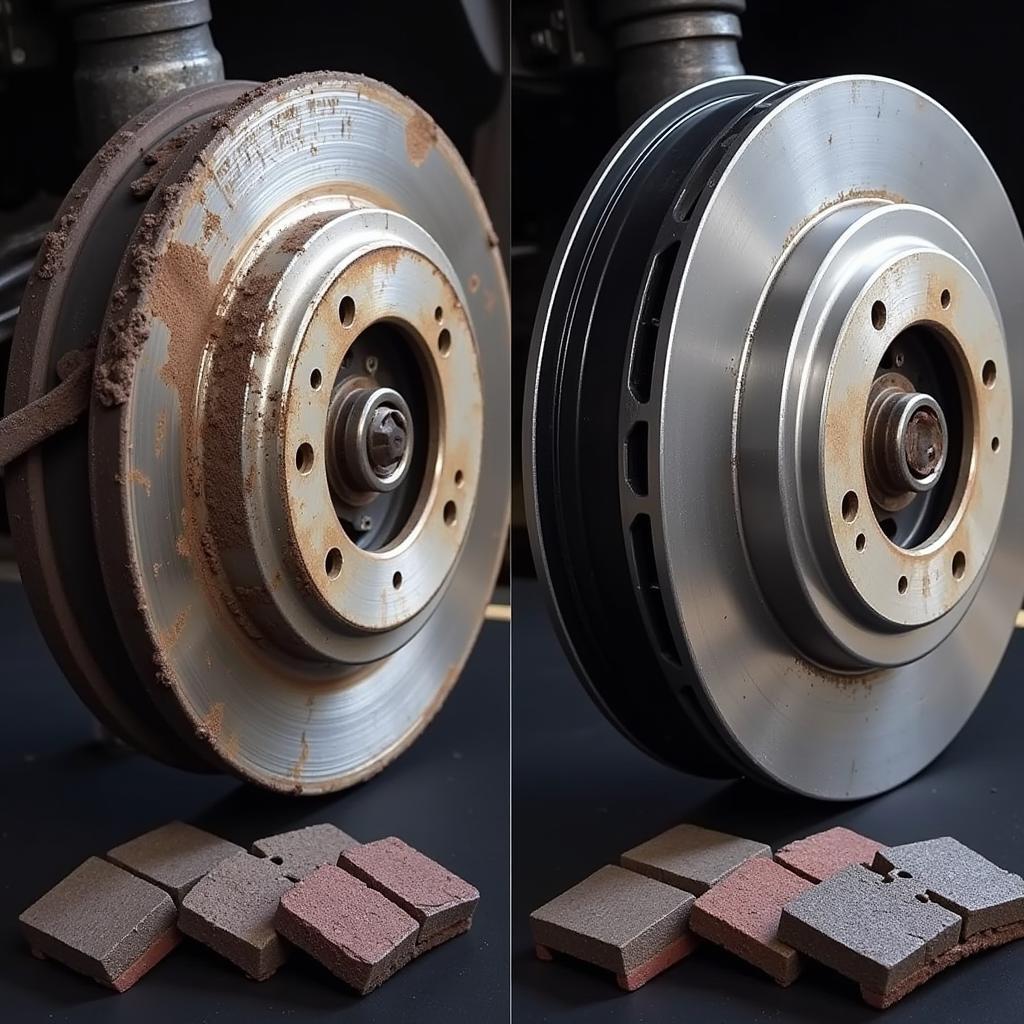The brake warning light is a crucial safety feature in your car. So, it’s natural to feel a jolt of worry when it illuminates, especially while braking. While a glowing brake light doesn’t always signal a catastrophic issue, it should never be ignored. This article will delve into the common reasons behind this issue, empowering you with the knowledge to address it effectively.
Understanding Your Car’s Braking System
Before we dive into the reasons behind a lit brake warning light, it’s helpful to grasp the basics of how your car’s braking system works. At its core, the system relies on hydraulic pressure to engage the brakes when you press the pedal. This pressure is generated in the master cylinder and transferred through brake lines to calipers (for disc brakes) or wheel cylinders (for drum brakes), pushing the brake pads or shoes against the rotors or drums, respectively, to slow down or stop the vehicle.
Common Causes of a Brake Warning Light
1. Low Brake Fluid Level
One of the most frequent culprits behind an illuminated brake warning light is a low brake fluid level. Brake fluid is the lifeblood of your car’s braking system, responsible for transmitting the force from your foot on the pedal to the wheels. If the fluid level drops too low, it often indicates a leak in the system or worn-down brake pads.
What to do: If you suspect low brake fluid, carefully check the brake fluid reservoir under the hood. If the fluid level is low, it’s crucial to have a mechanic inspect the system for leaks and address the root cause before driving further.
2. Worn Brake Pads
Brake pads are designed to wear down over time with regular use. When they become too thin, a sensor (in most modern cars) triggers the brake warning light to alert you that it’s time for a replacement.
What to do: If your brake pads are worn, it’s vital to have them replaced promptly. Driving with worn brake pads not only compromises your safety but can also lead to costly damage to the rotors.
 Comparison of worn brake pads and new brake pads
Comparison of worn brake pads and new brake pads
3. Brake Fluid Leak
As mentioned earlier, a brake fluid leak can lead to a low fluid level and trigger the warning light. Leaks can occur in various parts of the system, including the master cylinder, brake lines, hoses, and calipers.
What to do: A brake fluid leak demands immediate attention. If you notice a puddle of fluid under your car or a persistent drop in the fluid level, do not drive the vehicle. Have it towed to a mechanic to diagnose and repair the leak.
4. Faulty Brake Light Switch
The brake light switch, located near the brake pedal, is responsible for activating the brake lights when you press the pedal. A malfunctioning switch can disrupt this signal, leading to the brake warning light appearing on your dashboard, even if the braking system itself is functioning correctly.
What to do: A faulty brake light switch usually requires replacement. While not a complex repair, it’s best to have a qualified mechanic diagnose and address the issue.
5. ABS Issue
Modern cars are equipped with an Anti-lock Braking System (ABS) that prevents wheel lockup during hard braking, enhancing control and stability. If the ABS system encounters an issue, it can trigger the brake warning light.
What to do: When an ABS issue arises, it’s crucial to have your car diagnosed by a mechanic with the appropriate diagnostic tools to pinpoint the problem within the ABS system.
Brake Warning Light Comes On When Braking Hard: What Does It Mean?
If your brake warning light specifically illuminates when you apply the brakes forcefully, it often points to a problem within the braking system that requires immediate attention. Here’s a closer look at possible reasons:
- Air in the Brake Lines: Air trapped in the brake lines can compress, leading to a “spongy” brake pedal feel and reduced braking efficiency, especially during hard braking.
- Failing Brake Master Cylinder: The master cylinder plays a vital role in generating hydraulic pressure. A failing master cylinder might struggle to maintain adequate pressure, particularly under demanding braking situations.
- Worn Brake Hoses: Brake hoses, responsible for carrying brake fluid, can deteriorate over time. Worn hoses might expand under high pressure (during hard braking), reducing the force transmitted to the brakes.
Can I Drive with the Brake Warning Light On?
The short answer is no. Driving with an illuminated brake warning light is highly discouraged and potentially dangerous. A lit warning light indicates a problem with your braking system that could compromise your ability to stop safely, increasing the risk of an accident.
“Ignoring a brake warning light is like ignoring a flashing red light at a busy intersection,” says Jake Carter, a senior automotive engineer with over 15 years of experience. “It’s a gamble you should never take with your safety and the safety of others on the road.”
Conclusion
A brake warning light that comes on when braking is a serious safety concern that necessitates immediate attention. By understanding the potential causes and taking prompt action, you can ensure the proper functioning of your car’s braking system and prioritize your safety on the road. Remember, when it comes to brakes, it’s always better to err on the side of caution and seek professional help.

